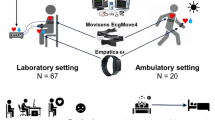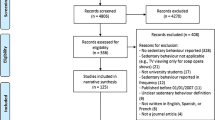Abstract
While diurnal temperature range (DTR) has been found to be a risk factor for mortality, evaluation of the underlying mechanisms involved in this association are lacking. To explain the association between DTR and health effects, we investigated how cardiovascular markers responded to DTR. Data was obtained from 560 participants who regularly attended a community elderly welfare center located in Seoul, Korea. Data collection was conducted a total of five times over a 3-year period beginning in August, 2008. We examined systolic and diastolic blood pressure (BP), heart rate (HR), and heart rate variability (HRV). Mixed-effects models and generalized additive mixed models were used to assess the relationship of DTR with BP, HR, and HRV. BP was not associated significantly with rapid temperature changes during the day. While HR was associated linearly with increments of DTR, the relationship between DTR and HRV showed nonlinear associations, or the presence of a cutoff around median DTR. At the cutoff level of DTR determined by an inflection point in the graph, standard deviation of normal-to-normal intervals (SDNN) and root mean square successive difference (RMSSD) were peaked, whereas the low frequency:high frequency (LF:HF) ratio was elevated with decreasing DTR below the cutoff level. The study demonstrated that HR increases with increasing temperature range during the day, and that HRV is reduced at small or large DTR, which suggests minimal cardiovascular stress around the median level of temperature range during the day.

Similar content being viewed by others
References
Cao J, Cheng Y, Zhao N, Song W, Jiang C, Chen R, Kan H (2009) Diurnal temperature range is a risk factor for coronary heart disease death. J Epidemiol 19(6):328–332
Chen G, Zhang Y, Song G, Jiang L, Zhao N, Chen B, Kan H (2007) Is diurnal temperature range a risk factor for acute stroke death? Int J Cardiol 116(3):408–409
Diaz A, Bourassa MG, Guertin M-C, Tardif J-C (2005) Long-term prognostic value of resting heart rate in patients with suspected or proven coronary artery disease. Eur Heart J 26(10):967–974
Easterling DR, Horton B, Jones PD, Peterson TC, Karl TR, Parker DE, Salinger MJ, Razuvayev V, Plummer N, Jamason P, Folland CK (1997) Maximum and minimum temperature trends for the globe. Science 277(5324):364–367
Ibald-Mulli A, Timonen KL, Peters A, Heinrich J, Wolke G, Lanki T, Buzorius G, Kreyling WG, de Hartog J, Hoek G, ten Brink HM, Pekkanen J (2004) Effects of particulate air pollution on blood pressure and heart rate in subjects with cardiovascular disease: a multicenter approach. Environ Health Perspect 112(3):369–377
Jung H-S, Choi Y, Oh J-H, Lim G-H (2002) Recent trends in temperature and precipitation over South Korea. Int J Climatol 22(11):1327–1337
Kamath MV, Fallen EL (1993) Power spectral analysis of heart rate variability: a noninvasive signature of cardiac autonomic function. Crit Rev Biomed Eng 21(3):245–311
Kan H, London SJ, Chen H, Song G, Chen G, Jiang L, Zhao N, Zhang Y, Chen B (2007) Diurnal temperature range and daily mortality in Shanghai, China. Environ Res 103(3):424–431
Kannel WB, Kannel C, Paffenbarger RS Jr, Cupples LA (1987) Heart rate and cardiovascular mortality: the Framingham Study. Am Heart J 113(6):1489–1494
KMA (2012) Korea Meteorological Administration. Available http://web.kma.go.kr/eng/index.jsp [accessed 3 August 2012]
Kristal-Boneh E, Silber H, Harari G, Froom P (2000) The association of resting heart rate with cardiovascular, cancer and all-cause mortality. Eight year follow-up of 3527 male Israeli employees (the CORDIS Study). Eur Heart J 21(2):116–124
Lewington S, Clarke R, Qizilbash N, Peto R, Collins R (2002) Age-specific relevance of usual blood pressure to vascular mortality: a meta-analysis of individual data for one million adults in 61 prospective studies. Lancet 360(9349):1903–1913
Liang WM, Liu WP, Kuo HW (2009) Diurnal temperature range and emergency room admissions for chronic obstructive pulmonary disease in Taiwan. Int J Biometeorol 53(1):17–23
Lim Y-H, Park A, Kim H (2012a) Modifiers of diurnal temperature range and mortality association in six Korean cities. Int J Biometeorol 56:33–42
Lim YH, Hong YC, Kim H (2012b) Effects of diurnal temperature range on cardiovascular and respiratory hospital admissions in Korea. Sci Total Environ 417–418:55–60
Liu W, Lian Z, Liu Y (2008) Heart rate variability at different thermal comfort levels. Eur J Appl Physiol 103(3):361–366
Makowski K (2009) The daily temperature amplitude and surface solar radiation. Dissertation, ETH Zurich
McCulloch CE, Neuhaus JM (2005) Generalized linear mixed models. Encyclopedia of Biostatistics
Mowery NT, Morris Jr JA, Jenkins JM, Ozdas A, Norris PR (2011) Core temperature variation is associated with heart rate variability independent of cardiac index: a study of 278 trauma patients. J Crit Care 26(5):534. e9-534.e17
Okamoto-Mizuno K, Tsuzuki K, Mizuno K, Ohshiro Y (2009) Effects of low ambient temperature on heart rate variability during sleep in humans. Eur J Appl Physiol 105(2):191–197
Park SK, O'Neill MS, Vokonas PS, Sparrow D, Schwartz J (2005) Effects of air pollution on heart rate variability: the VA normative aging study. Environ Health Perspect 113(3):304–309
Ren C, Park SK, O'Neill MS, SparrowD, Vokonas P, Schwartz J (2011) Ambient temperature, air pollution, and heart rate variability in an aging population. Am J Epidemiol 173(9):1013–1021
Schifano P, Cappai G, De Sario M, Michelozzi P, Marino C, Bargagli AM, Perucci CA (2009) Susceptibility to heat wave-related mortality: a follow-up study of a cohort of elderly in Rome. Environ Health 8:50
Schroeder EB, Liao D, Chambless LE, Prineas RJ, Evans GW, Heiss G (2003) Hypertension, blood pressure, and heart rate variability. Hypertension 42(6):1106–1111
Sesso HD, Stampfer MJ, Rosner B, Hennekens CH, Gaziano JM, Manson JE, Glynn RJ (2000) Systolic and diastolic blood pressure, pulse pressure, and mean arterial pressure as predictors of cardiovascular disease risk in men. Hypertension 36(5):801–807
Song G, Chen G, Jiang L, Zhang Y, Zhao N, Chen B, Kan H (2008) Diurnal temperature range as a novel risk factor for COPD death. Respirology 13(7):1066–1069
Tam WW, Wong TW, Chair SY, Wong AH (2009) Diurnal temperature range and daily cardiovascular mortalities among the elderly in Hong Kong. Arch Environ Occup Health 64(3):202–206
Task Force of the European Society of Cardiology the North American Society of Pacing Electrophysiology (1996) Heart rate variability: standards of measurement, physiological interpretation, and clinical use. Circulation 93(5):1043–1065
Tong S, Ren C, Becker N (2010) Excess deaths during the 2004 heatwave in Brisbane, Australia. Int J Biometeorol 54(4):393–400
Wang K, Ye H, Chen F, Xiong Y, Wang C (2012) Urbanization effect on the diurnal temperature range: different roles under solar dimming and brightening*. J Clim 25(3):1022–1027
Wolf K, Schneider A, Breitner S, von Klot S, Meisinger C, Cyrys J, Hymer H, Wichmann HE, Peters A (2009) Air temperature and the occurrence of myocardial infarction in Augsburg, Germany. Circulation 120(9):735–742
Zhang C, Tang H, Li Q, Chen J (2009) Regional climate variations in South China related to global climate change and local urbanization. Adv Water Resour Hydraul Eng 2009:60–65
Zhou L, Dai A, Dai Y, Vose R, Zou C-Z, Tian Y, Chen H (2009) Spatial dependence of diurnal temperature range trends on precipitation from 1950 to 2004. Clim Dyn 32(2):429–440
Acknowledgments
H. K. and Y.-H. L. were partially supported by Basic Science Research Program (#2010-0009581) and Global Research Lab (#K21004000001-10A0500-00710) through the National Research Foundation of Korea (NRF) funded by the Ministry of Education, Science, and Technology.
Author information
Authors and Affiliations
Corresponding author
Electronic supplementary material
Below is the link to the electronic supplementary material.
ESM 1
(DOC 147 kb)
Rights and permissions
About this article
Cite this article
Lim, YH., Kim, H., Kim, J.H. et al. Effect of diurnal temperature range on cardiovascular markers in the elderly in Seoul, Korea. Int J Biometeorol 57, 597–603 (2013). https://doi.org/10.1007/s00484-012-0587-x
Received:
Revised:
Accepted:
Published:
Issue Date:
DOI: https://doi.org/10.1007/s00484-012-0587-x




